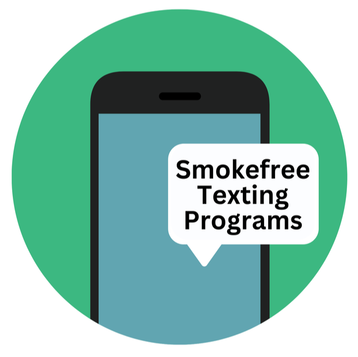The LiveWell program is committed to supporting individuals on their journey towards a living a smoke-free lifestyle and providing a tobacco free workplace at WKKF.
Recognizing the challenges associated with tobacco use, there is no one answer for how to quit smoking. You have to be ready, committed and then find the strategy that works best for you. This resource page aims to provide a comprehensive look at the benefits of not smoking and some useful tools to help empower you to break free from the grips of smoking or other types of tobacco use to improve your health.
Whether you're just starting your cessation journey or seeking additional support, we are ready with valuable information, practical tips, and a supportive community to guide you towards a healthier, tobacco-free lifestyle. If you need additional coaching support from the LiveWell team don't hesitate to reach out. We are here to help keep you motivated as you work towards reaching your goals in the future.
Take the first step towards a smoke-free future today – your future self will thank you!
Recognizing the challenges associated with tobacco use, there is no one answer for how to quit smoking. You have to be ready, committed and then find the strategy that works best for you. This resource page aims to provide a comprehensive look at the benefits of not smoking and some useful tools to help empower you to break free from the grips of smoking or other types of tobacco use to improve your health.
Whether you're just starting your cessation journey or seeking additional support, we are ready with valuable information, practical tips, and a supportive community to guide you towards a healthier, tobacco-free lifestyle. If you need additional coaching support from the LiveWell team don't hesitate to reach out. We are here to help keep you motivated as you work towards reaching your goals in the future.
Take the first step towards a smoke-free future today – your future self will thank you!
There are several compelling reasons not to smoke, all of which contribute to the overall improvement of one's health and well-being. Some of the main reasons include:
- Health Risks: Smoking is a leading cause of various serious health conditions, including lung cancer, heart disease, respiratory disorders, and more. Quitting smoking significantly reduces the risk of developing these life-threatening illnesses.
- Long-term Health Benefits: Choosing not to smoke or quitting smoking leads to long-term health benefits, such as improved lung function, better cardiovascular health, and a lower risk of chronic diseases.
- Financial Savings: Smoking can be an expensive habit. Choosing not to smoke or quitting can result in substantial financial savings, as money spent on cigarettes can be redirected towards other priorities.
- Improved Physical Fitness: Smoking can impair physical fitness by reducing stamina and lung capacity. Choosing not to smoke or quitting can lead to improved athletic performance and overall physical well-being.
- Enhanced Appearance: Smoking can contribute to premature aging and affect physical appearance. Quitting smoking can lead to healthier skin, teeth, and overall improved physical appearance.
- Secondhand Smoke Risks: Not smoking protects not only your health but also the health of those around you. Secondhand smoke poses significant risks to non-smokers, particularly children and pregnant women.
- Better Quality of Life: Smoking can impact the quality of life by limiting physical activities, causing discomfort, and reducing overall well-being. Choosing not to smoke or quitting can lead to a more fulfilling and enjoyable life.
- Social Benefits: Smoking restrictions in public places and changing social norms mean that choosing not to smoke can contribute to better social interactions and relationships, as smoking is increasingly viewed as a socially undesirable habit.
- Reduced Stress: While some may turn to smoking as a stress-relief method, the long-term impact can be detrimental. Quitting smoking can lead to healthier stress management strategies and an overall reduction in stress levels.
- Positive Role Modeling: Choosing not to smoke sets a positive example for others, especially younger individuals. Being a non-smoker can influence friends, family, and the broader community in making healthier choices.
Set a Quit Date
Choose a specific date to quit smoking. This gives you time to prepare mentally and allows you to plan for potential challenges.
Understand Your Triggers
Identify situations, emotions, or activities that trigger your urge to smoke. This awareness will help you develop strategies to cope with these triggers.
Seek Support
Inform friends, family, and coworkers about your decision to quit. Having a support system can provide encouragement and accountability.
Consider Nicotine Replacement Therapy (NRT)
Consult with a healthcare professional to discuss the use of nicotine replacement products like patches, gum, or lozenges. These can help manage withdrawal symptoms.
Create a Smoke-Free Environment
Remove cigarettes, lighters, and ashtrays from your home, car, and workplace. Make these spaces smoke-free to reduce the temptation to smoke.
Develop Coping Strategies
Identify alternative coping mechanisms for stress, boredom, or other triggers. This could include deep breathing exercises, exercise, or engaging in a hobby.
Stay Active
Regular physical activity can help reduce cravings and improve your mood. Consider incorporating exercise into your daily routine.
Join a Support Group
Connect with others who are also trying to quit smoking. Support groups provide a sense of community and shared experiences.
Mindfulness and Relaxation Techniques
Practice mindfulness or relaxation exercises to manage stress. Techniques such as meditation and deep breathing can be beneficial.
Reward Yourself
Set up a reward system for reaching milestones in your journey to quit smoking. Treat yourself to something special as a positive reinforcement.
Educate Yourself
Learn about the health benefits of quitting smoking. Understanding the positive impact on your health can motivate you to stay smoke-free.
Prepare for Cravings
Have a plan for dealing with cravings. Distract yourself, drink water, or chew gum when the urge to smoke arises.
Professional Help
Consider seeking professional help, such as counseling or therapy, to address any underlying psychological factors contributing to your smoking habit.
Stay Persistent
Quitting smoking is a process, and setbacks may occur. If you slip up, don't be too hard on yourself. Learn from the experience and refocus on your goal.
Celebrate Success
Acknowledge and celebrate your achievements along the way. Celebrate each day, week, and month of being smoke-free.
Choose a specific date to quit smoking. This gives you time to prepare mentally and allows you to plan for potential challenges.
Understand Your Triggers
Identify situations, emotions, or activities that trigger your urge to smoke. This awareness will help you develop strategies to cope with these triggers.
Seek Support
Inform friends, family, and coworkers about your decision to quit. Having a support system can provide encouragement and accountability.
Consider Nicotine Replacement Therapy (NRT)
Consult with a healthcare professional to discuss the use of nicotine replacement products like patches, gum, or lozenges. These can help manage withdrawal symptoms.
Create a Smoke-Free Environment
Remove cigarettes, lighters, and ashtrays from your home, car, and workplace. Make these spaces smoke-free to reduce the temptation to smoke.
Develop Coping Strategies
Identify alternative coping mechanisms for stress, boredom, or other triggers. This could include deep breathing exercises, exercise, or engaging in a hobby.
Stay Active
Regular physical activity can help reduce cravings and improve your mood. Consider incorporating exercise into your daily routine.
Join a Support Group
Connect with others who are also trying to quit smoking. Support groups provide a sense of community and shared experiences.
Mindfulness and Relaxation Techniques
Practice mindfulness or relaxation exercises to manage stress. Techniques such as meditation and deep breathing can be beneficial.
Reward Yourself
Set up a reward system for reaching milestones in your journey to quit smoking. Treat yourself to something special as a positive reinforcement.
Educate Yourself
Learn about the health benefits of quitting smoking. Understanding the positive impact on your health can motivate you to stay smoke-free.
Prepare for Cravings
Have a plan for dealing with cravings. Distract yourself, drink water, or chew gum when the urge to smoke arises.
Professional Help
Consider seeking professional help, such as counseling or therapy, to address any underlying psychological factors contributing to your smoking habit.
Stay Persistent
Quitting smoking is a process, and setbacks may occur. If you slip up, don't be too hard on yourself. Learn from the experience and refocus on your goal.
Celebrate Success
Acknowledge and celebrate your achievements along the way. Celebrate each day, week, and month of being smoke-free.
Triggers are the things that make you want to smoke. Different people have different triggers, but most fall into one of four categories, EMOTIONAL, PATTERN, SOCIAL OR WITHDRAWL.
Recognizing your triggers and understanding what strategies work for you to overcome will assist you in your quit journey.
- An emotional trigger reminds you how you felt when you used smoking to enhance a good mood or escape a bad one.
- Like stress, excitement, happiness, boredom, calming down after a fight.
- A pattern trigger is an activity that you connect with smoking.
- Like driving, finishing a meal, before bed, drinking alcohol.
- Social triggers are occasions that usually include other people who smoke.
- Like going to the bar, seeing someone else smoke, friends who you may smoke with.
- If you’ve been a long-time smoker, your body is used to getting a regular dose of nicotine. When you quit, withdrawal symptoms will produce cravings for nicotine.
- Like smelling smoke, feeling restless, urge to use hands or mouth, craving the taste.
Recognizing your triggers and understanding what strategies work for you to overcome will assist you in your quit journey.
|
QuitGuide
Helps You:
quitSTART Helps You:
|
|
There are free text messaging programs with 24/7 encouragement, advice and tips to become smoke free. Check out which program works best for you below: SmokefreeTXT is designed for people across the U.S. who are ready to quit smoking. SmokefreeTXT for Teens is designed for teens ages 13-17 who are ready to quit. SmokefreeNATIVE is designed for Native American people ready to quit smoking commercial tobacco. SmokefreeVET is designed for Veterans with VA health care benefits who are ready to quit. SmokefreeMOM is designed for pregnant women who want to cut back and quit smoking. DipfreeTXT is designed for young adults ready to quit smokeless tobacco. Spanish Options: SmokefreeTXT or SmokefreeVet |

|





